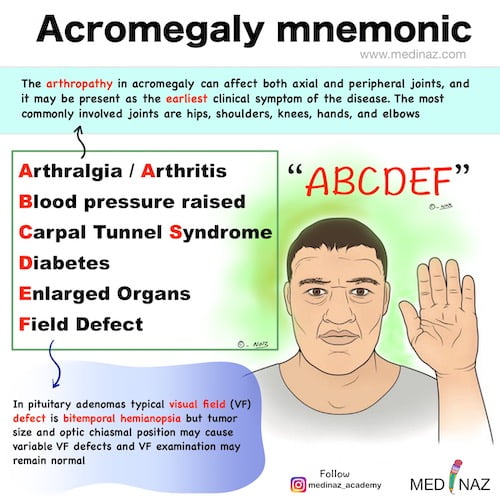Acromegaly USMLE Notes & mnemonics contains all the high-yield points you need to know.
Definition:
- Acromegaly: A rare hormonal disorder caused by excess growth hormone (GH) production, usually due to a pituitary adenoma. (Ref)
Pathophysiology:
- GH Hypersecretion: Leads to liver producing more Insulin-Like Growth Factor 1 (IGF-1), promoting growth of bones and soft tissues.
- Pituitary Adenoma: Most common cause.
Epidemiology:
- Typically diagnosed in middle-aged adults.
- Rare, with an incidence of about 3 per million per year.
Clinical Features:
- Enlarged Hands and Feet
- Coarse Facial Features: Prognathism, enlarged nose, lips, and tongue.
- Macroglossia
- Sweating and Skin Tags
- Joint Pain and Arthritis
- Carpal Tunnel Syndrome
- Hypertension, Cardiomegaly
- Impaired Glucose Tolerance/Diabetes
Diagnosis:
- Elevated IGF-1 Levels: Reflects integrated GH levels.
- Oral Glucose Tolerance Test (OGTT): Lack of GH suppression after glucose administration confirms diagnosis.
- MRI of the Pituitary Gland: To detect adenoma.
Management:
- Transsphenoidal Surgery: First-line for pituitary adenomas.
- Somatostatin Analogs (e.g., Octreotide, Lanreotide): Reduce GH production.
- GH Receptor Antagonists (e.g., Pegvisomant): Block GH effects.
- Dopamine Agonists (e.g., Cabergoline): Reduce GH in some patients.
- Radiation Therapy: For uncontrolled cases after surgery and medications.
Complications:
- Cardiovascular Disease
- Sleep Apnea
- Colon Polyps and Increased Risk of Colorectal Cancer
- Hypopituitarism (post-treatment)
Prognosis:
- Normal life expectancy if adequately treated; increased mortality if untreated, primarily due to cardiovascular complications.
Mnemonic: “ACRO-MEGALY”
- Adults (commonly middle-aged)
- Coarse facial features
- Ring size increases (enlarged hands)
- Organomegaly (heart, liver, etc.)
- Macroglossia
- Enlarged feet
- Growth hormone excess
- Arthralgia
- Lanreotide & Octreotide (treatment options)
- You see pituitary adenoma on MRI

Chart: Diagnostic Approach to Acromegaly
| Test | Purpose | Expected Finding |
|---|---|---|
| IGF-1 Level | Screening test | Elevated |
| Oral Glucose Tolerance Test | Confirmatory test | Failure to suppress GH |
| MRI of Pituitary | Identify adenoma | Pituitary adenoma visible |
Note: For the USMLE, focus on the classic presentation of acromegaly, including its insidious onset and distinctive physical changes. Recognize the importance of IGF-1 and OGTT in diagnosis and understand the first-line treatments and their purposes. Be aware of the complications and the need for lifelong follow-up due to the risk of tumor recurrence and development of comorbid conditions.
Check other important USMLE Notes
A Visual Learning Platform





